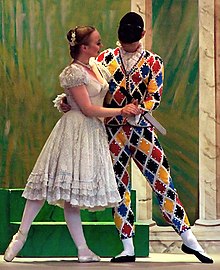Dance around the world
South Asia
There are now many regional varieties of Indian classical dance. Dances like "Odra Magadhi", which after decades long debate, has been traced to present day Mithila, Odisha region's dance form of Odissi (Orissi), indicate influence of dances in cultural interactions between different regions.[13]
The Punjab area overlapping India and Pakistan is the place of origin of Bhangra. It is widely known both as a style of music and a dance. It is mostly related to ancient harvest celebrations, love, patriotism or social issues. Its music is coordinated by a musical instrument called the 'Dhol'. Bhangra is not just music but a dance, a celebration of the harvest where people beat the dhol (drum), sing Boliyaan (lyrics) and dance.It developed further with the Vaisakhi festival of the Sikhs.
The dances of Sri Lanka include the devil dances (yakun natima), a carefully crafted ritual reaching far back into Sri Lanka's pre-Buddhist past that combines ancient "Ayurvedic" concepts of disease causation with psychological manipulation and combines many aspects including Sinhalese cosmology. Their influence can be seen on the classical dances of Sri Lanka.[14]
Europe and North America
Main article: Concert dance
Ballet
developed first in Italy and then in France from lavish court
spectacles that combined music, drama, poetry, song, costumes and dance.
Members of the court nobility took part as performers. During the reign
of Louis XIV,
himself a dancer, dance became more codified. Professional dancers
began to take the place of court amateurs, and ballet masters were
licensed by the French government. The first ballet dance academy was
the Académie Royale de Danse (Royal Dance Academy), opened in Paris in
1661. Shortly thereafter, the first institutionalized ballet troupe,
associated with the Academy, was formed; this troupe began as an
all-male ensemble but by 1681 opened to include women as well.[5]20th century concert dance brought an explosion of innovation in dance style characterized by an exploration of freer technique. Early pioneers of what became known as modern dance include Loie Fuller, Isadora Duncan, Mary Wigman and Ruth St. Denis. The relationship of music to dance serves as the basis for Eurhythmics, devised by Emile Jaques-Dalcroze, which was influential to the development of Modern dance and modern ballet through artists such as Marie Rambert. Eurythmy, developed by Rudolf Steiner and Marie Steiner-von Sivers, combines formal elements reminiscent of traditional dance with the new freer style, and introduced a complex new vocabulary to dance. In the 1920s, important founders of the new style such as Martha Graham and Doris Humphrey began their work. Since this time, a wide variety of dance styles have been developed; see Modern dance.
African American dance developed in everyday spaces, rather than in dance studios, schools or companies. Tap dance, disco, jazz dance, swing dance, hip hop dance, the lindy hop with its relationship to rock and roll music and rock and roll dance have had a global influence.




0 comments:
Post a Comment